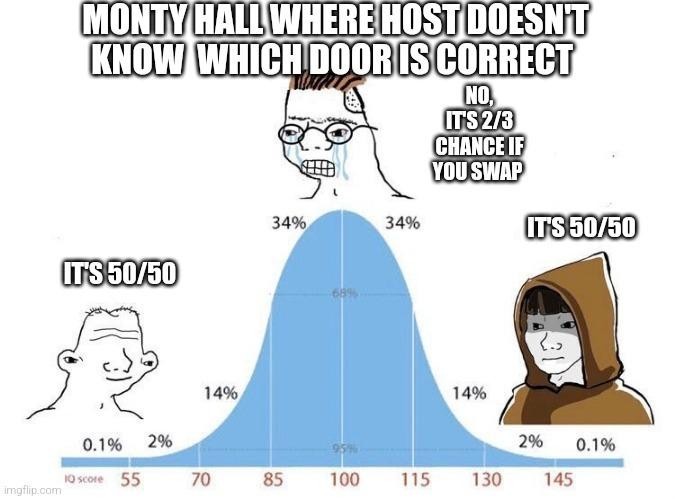views
About the Meme and Game Story:

The meme uses the popular "IQ scale" format, featuring various "Soyjak" and "Chad" archetypes positioned along a bell curve representing intelligence levels.
At the extremes, characters declare "It's 50/50," representing common, yet incorrect, intuition about the Monty Hall Problem. In the middle, near the average IQ, a crying character states, "No, it's 2/3 chance if you swap," correctly identifying the optimal strategy, but perhaps expressing frustration at the counter-intuitive nature of the solution.
The top text, "MONTY HALL WHERE HOST DOESN'T KNOW WHICH DOOR IS CORRECT," humorously introduces a common misconception or variation that people often bring up to argue against the 2/3 probability.
The Game Story of the Monty Hall Problem: From "Let's Make a Deal" to National Debate
The legendary puzzle known as the Monty Hall Problem didn't originate in a textbook; it sprang directly from the captivating, often chaotic, atmosphere of the popular American game show, "Let's Make a Deal." Hosted by the charismatic Monty Hall himself, the show, which first aired in the 1960s, was renowned for its bizarre costumes, spontaneous deals, and, of course, its climactic "Big Deal" segment.
The setup for the now-famous problem was simple, yet deceptively profound:
-
The Choice: A contestant stands before three large doors. Behind one door, a fantastic prize awaits – typically a brand-new car. Behind the other two, there are consolation "zonks," most famously represented by a goat. The contestant is invited to choose one door. Let's imagine our contestant, let's call her Alice, confidently points to Door #1.
-
Monty's Reveal (The Crucial Step): This is where Monty Hall's unique role comes into play. Crucially, Monty always knows which door hides the car. After Alice makes her initial selection (Door #1), Monty, with a flourish, opens one of the two unchosen doors that he knows contains a goat. Let's say he opens Door #3, revealing a bleating goat.
-
The Offer to Switch: Monty then turns to Alice and poses the critical question: "Alice, now that you see a goat behind Door #3, do you want to stick with your original choice, Door #1, or would you like to switch to Door #2?"
The Great American Uproar: Intuition vs. Logic
For most people, the immediate, gut-level reaction is to think, "Well, now there are only two doors left, and one has the car, the other has a goat. So it's 50/50, right? It doesn't matter if I switch or stay." This intuitive leap, however, is precisely where the problem becomes a paradox to many.
The correct, statistically proven answer is that the contestant should always switch doors. By switching, the probability of winning the car doubles from 1/3 to 2/3.
This counter-intuitive solution ignited a massive public reaction in America, particularly after the problem was famously posed by Marilyn vos Savant in her "Ask Marilyn" column in Parade Magazine in 1990. Vos Savant, who holds the Guinness World Record for highest recorded IQ, stated unequivocally that switching was the correct strategy.
The response was unprecedented. Thousands upon thousands of letters flooded Parade's offices, many from academics, mathematicians, and scientists, vehemently arguing that vos Savant was wrong. They insisted it had to be 50/50. Professors from prestigious universities wrote in, often with condescending tones, "explaining" her supposed error. One letter from a Ph.D. in mathematics reportedly stated, "You blew it, and you'll hear from me again if you don't own up to your mistake." Even the renowned mathematician Paul Erdős initially disbelieved the solution until presented with a computer simulation.
The sheer volume and intensity of the backlash highlighted a fascinating psychological phenomenon: how deeply entrenched intuition can resist even clear logical and probabilistic proof. People found it incredibly difficult to grasp that Monty's act of opening a door was not a random event; it was a deliberate revelation based on his knowledge, which effectively concentrated the initial 2/3 probability of the car being behind one of the other two doors onto the single remaining unopened door.
The Monty Hall Problem became a cultural touchstone, a testament to the power of probability to confound human intuition, and a lasting legacy of a simple game show premise that sparked a national debate about logic, statistics, and even intelligence.




















Comments
0 comment